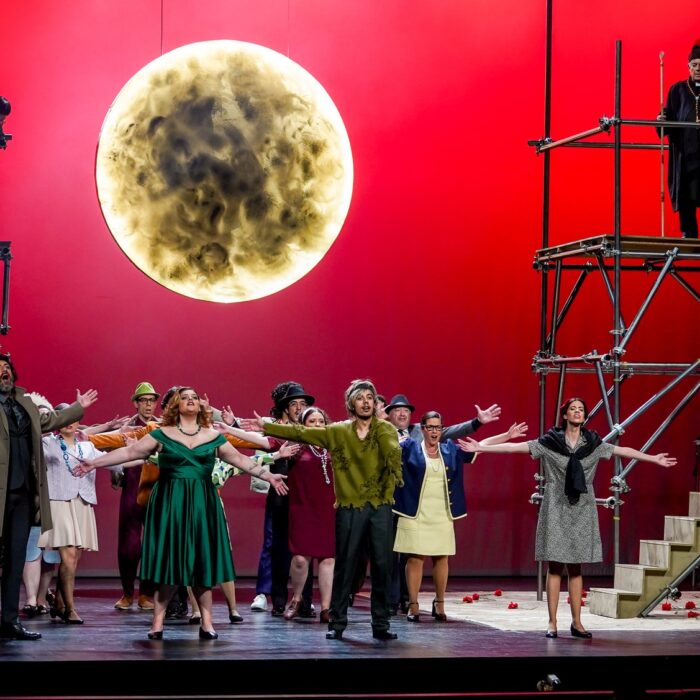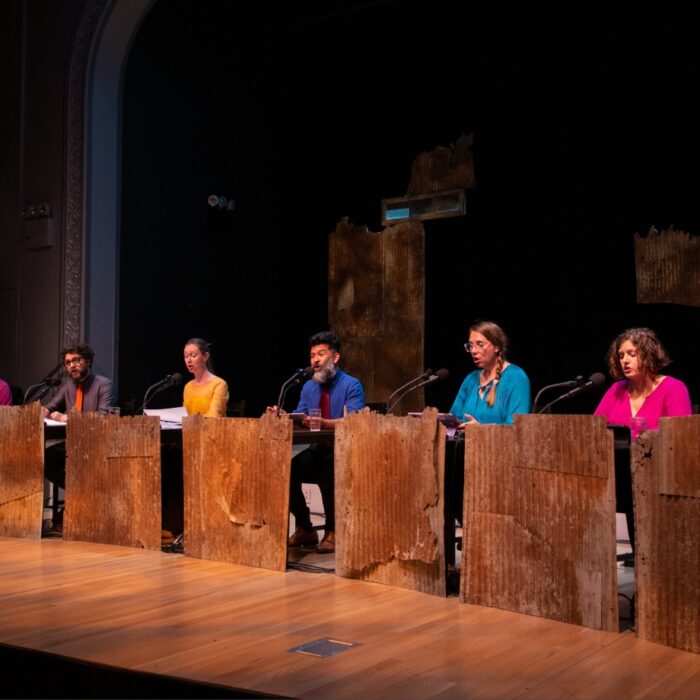
Irish National Opera 2023-24 Review: L’Olimpiade
Peter Whelan Leads a Musically Strong Production
By Alan Neilson(Photo: Ros Kavanagh)
Intricate and convoluted plots are not exactly rare in operas of the 17th and 18th centuries. Usually revolving around mistaken identities, complex love triangles, misunderstandings and deliberate deceptions that precipitate extreme emotions, their narratives career forward, plunging the protagonists into life-threatening and life-changing situations in which the gods, heroes and mythical characters often play their part. Vivaldi’s 1734 opera “L’Olimpiade,” to a libretto by Pietro Metastasio, is a typical example of the form, however, Irish National Opera’s imaginative and clearly focused production ensured that its audience had little trouble following its tangled storyline.
Before the opera even begins, the audience needs to be aware of an elaborate backstory that centers on two couples: Megacle and Aristea, and Licida and Argene. They are deeply in love but have been forbidden to marry by their fathers. Megacle also happens to be a close friend of Licida, who saved his life. The distraught Argene has fled her home and is now disguised as a shepherdess, while Aristea’s father, King Clistene, is offering her hand in wedlock as the prize for the winner of the Olympic games. Meanwhile, Licida has now given up on Argene, fallen in love with Aristea, and wants to win her at the forthcoming games, but not being very good at athletics he has asked Megacle to compete for him, who, unaware that his love, Aristea, is the prize, agrees. The scene is thereby set up for a series of confrontations based around mistaken identities, misunderstandings and heartbreak, and this is just a simplified version!
Evans’ Clear and Imaginative Vision
Director Daisy Evans did a fine job of streamlining the action into a coherent, sharp staging, even though she added her own twist to the plot. She begins the evening with a troupe of actors, who, during the overture, are assigned their roles and costumes and ready themselves for the performance. During the performance, the cast members all play two roles: firstly, their assigned role in the opera, and secondly, as a member of the troupe. Over the course of the evening, the two separate narratives collide as the offstage and onstage love affairs become entangled. It was all neatly crafted, and surprisingly, the two narratives were not difficult to follow; when in character, they dressed appropriately, but when playing a troupe member, they ditched the costume and reverted to largely plain white attire. Licida’s servant, Aminta, however, stands outside the general melee and plays the role of the director, so that her anxieties tended to relate to the chaos within the troupe rather than actual tensions arising from the narrative.
When the characters left the stage, they positioned themselves on its edges as the actors and watched what was going on. Shortly before their entrance, they would quickly don their costumes. The contagion between the offstage and onstage personas was both clever and, at times, amusing, as their passions were allowed to inform each other.
The scenography and the costumes were in the hands of Molly O’Cathain. Her costume designs were largely of the 18th century, but with the occasional oddities thrown in. For example, all the characters wore boots typically worn by boxers, and Aminta was dressed in a Jockeys’ silks. Although the single set was very simple in conception, it was also very successful in creating a sense of the Olympic Games. Consisting of a black, tiered, raked semi-circle with lights running along each level, it immediately brought to mind an ancient Greek amphitheater. It was also easy to move and rearrange so that different perspectives could be quickly manufactured. A circular halo-style hung over the centre of the stage, which, along with Jake Wiltshire’s, imaginative and fast-changing lighting designs, not only created the necessary atmospheric effects, but also added color to the staging.
This is the third Vivaldi opera that Irish National Opera has presented in the past five years, and the standard of the orchestral playing, which has always been high, keeps on rising. For this performance of “L’Olimpiade,” the Irish Baroque Orchestra, under the musical direction of Peter Whelan, produced a superb performance of real quality. Their playing possessed an enticing textural clarity with a rhythmic bite that carried the listener along while at the same time supporting the onstage drama. It was in turn energetic and intense, sensitive and gentle. The overall balance and pace were pleasingly maintained throughout.
Although the singing performances were strong, the singers proved to be a disparate group in the ways they approached their roles, ranging from the artistically stylized and detailed, in which the emotions were captured through careful ornamentation and subtle inflections, to the vocally demonstrative, in which the emotions were allowed to run with a greater sense of freedom through the use of heavier accenting, greater floridity and an increasing sense of realism.
A Standout Performance from Meili Li
Countertenor Meili Li exemplified the first case with a fabulous singing portrait of Licida, in which he often appeared nonplussed by the complex goings-on of which he was often in the dark, and to which he even added the occasional moments of humor. His voice possesses a beautifully clear, consistent, homogenous tonal quality, which he used with a wonderful degree of agility to craft detailed vocal lines full of subtle accents, dynamic inflections and delightful ornamentations to express his feelings. Recitatives were sung with clarity and meaning, and the arias were expertly fashioned to bring out his layered emotions. His treatment of the aria “Mentre dormi, Amor formenti” was beautifully presented and proved to be one of the high points of the evening. Against the background of a sensitive orchestral accompaniment, he spun out wonderfully crafted phrases that showed off his pleasing legato, tonal consistency and ability to embellish the line, which successfully captured the full emotional force of the aria.
At the other end of the spectrum, yet equally compelling, was mezzo-soprano Alexandra Urquiola, who fashioned an emotionally charged rendition of Aristea. Sacrificing a degree of delicacy and subtlety, she engaged fully with her character’s feelings, successfully voicing the intensity of her pain and frustrations. Allowing herself a great deal of freedom, she injected plenty of color and dynamic and emotional accents into her singing as she plunged headfirst into a whirlpool full of anxiety, stress, frustration and unease. Her short aria, “Tu da me dividi,” in which she rages at Megacle’s falsity, was brilliantly crafted; every word, every sentence was enveloped by her anger as she spat out her lines.
Soprano Rachel Redmond has such a beautiful voice that listening to her sing is a pleasure on its own, regardless of the dramatic context. Nevertheless, it is not something she herself neglected, as she moved calmly around the stage, attempting to keep the actors on track in her role as the director. It was her three arias, however, that really stood out, for which she produced three delightful renditions, of which the second, “Siam navi all’onde algenti,” was the most captivating, as her voice danced along the line. Redmond possesses a light, agile voice with a natural musicality that she uses with sensitivity and apparent effortlessness to craft graceful coloraturas, delightfully soft trills and intricate embellishments.
Mezzo-soprano Gemma Ni Bhriain produced a strident and expressively strong performance in the role of Megacle. While she successfully captured her character’s passion and frustrations with her strong accents and injections of color, she was short on delicacy and finesse. All too often, one could feel the effort that was being made, which compromised her singing. It is possible that a little more relaxed and reflective approach would add to her appeal.
Argene was brought convincingly to life by mezzo-soprano Sarah Richmond with a focused, confident and energetic reading in what was a multi-layered portrayal. She possesses an agile, expressive voice, which she used intelligently and sensitively to craft detailed recitatives that successfully captured their dramatic impact, while her arias allowed her to show off her beautiful phrasing and pleasing coloratura.
Baritone Chuma Sijeqa created an aloof and authoritative King Clistene. Although his singing was clear and correct, there was not enough dynamic or tonal variation to fill out the character, and at times he sounded a little monotonous.
In the relatively low-profile role of the messenger Alcandro, baritone Seán Boylan managed to make a good impression, creating a clearly defined impression of a haughty, self-important, serious individual.
Overall, this was an excellent production in which Irish National Opera confirmed its credentials in being able to stage operas from the baroque period in general and Vivaldi in particular at a high level. And much of the credit must go to the conductor, Peter Whelan, and the Irish Baroque Orchestra, whose playing was truly excellent. At the final curtain call, everyone received a warm and well-deserved ovation.
I caught the performance in the small northern town of Letterkenny, where it played for one night before moving on to further venues across Ireland. Later in the season, there will be eight performances at The Royal Opera in London, followed by three nights in Fribourg, Switzerland.



